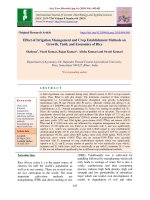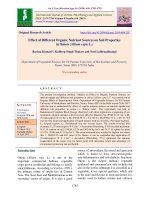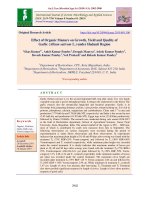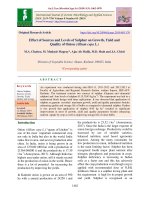Effect of various organic manures with biofertilizers on growth, yield and economics of onion (Allium cepa L.)
Bạn đang xem bản rút gọn của tài liệu. Xem và tải ngay bản đầy đủ của tài liệu tại đây (166.16 KB, 8 trang )
Int.J.Curr.Microbiol.App.Sci (2019) 8(1): 3092-3099
International Journal of Current Microbiology and Applied Sciences
ISSN: 2319-7706 Volume 8 Number 01 (2019)
Journal homepage:
Original Research Article
/>
Effect of Various Organic Manures with Biofertilizers on Growth,
Yield and Economics of Onion (Allium cepa L.)
Kalpana Nirala, Shailaja Punetha*, S.C. Pant and Sandeep Upadhaya
Department of Vegetable Science, 3Department of Soil science, College of Horticulture, VCSG
UUHF, Bharsar, PauriGarhwal, Uttarakhand, India-246123
*Corresponding author
ABSTRACT
Keywords
Biofertilizer,
Growth, Yield,
Economics, Onion,
Organic manure
Article Info
Accepted:
26 December 2018
Available Online:
10 January 2019
An experiment was conducted at the Organic Production Block, College of Horticulture,
VCSG Uttarakhand University of Horticulture and Forestry, Bharsar, Uttarakhand during
the year 2016. The experiment was laid out in randomized block design with three
replicated and 9 treatments viz., T 1 Control, T2 Vermicompost, T3 FYM, T4 Goat manure,
T5 Neem cake, T6 Vermicompost + FYM + Goat manure, T 7 Vermicompost + FYM +
Neem cake, T8 Vermicompost + Goat manure + Neem cake, T9 FYM + Goat manure +
Neem cake. The observations were recorded on different growth and yield attributes.
Further, economics of different treatments was also worked out. The analysis of variance
revealed significant differences among the treatments for all the characters under study.
The treatment T3 FYM due to its persistent performance for yield (324.46 q/ha), gross
income (Rs. 324460.00 q/ha), net returns (Rs. 251680.04 q/ha) and higher benefit: cost
ratio (1:3.45). Thus, it can be concluded from the findings that application of FYM
(2.8kg/1.2m2) can be recommended for commercial cultivation of onion.
Introduction
Onion (Allium cepa L.) is one of the most
important commercial vegetable crops
cultivated extensively in India and belongs to
the family Alliaceae and originated from the
central Asia (Thamburaj and Singh, 2001). It
is an indispensable item in every kitchen as
vegetable and condiment. It is one of the few
versatile vegetable crops that can be kept for a
fairly long period and can safely with stand
the hazards of rough handling long distance
transport. Organic manures are considered
helpful in improving the physical and
nutritional status of the soil and also enhance
the activity of soil microflora. They also add
considerable amount of major nutrients in the
soil besides, improving the soil properties.
Further, decomposition of organics in the soil
leads to different types of biological reactions
which are helpful in preventing various
diseases causing pathogens (Ramesh et al.,
2010). Biofertilizers offer an economically
attractive and ecologically sound means of
reducing external inputs and improving
quality and quantity of vegetable produce.
They contain microorganisms which are
capable of mobilizing nutrient elements from
3092
Int.J.Curr.Microbiol.App.Sci (2019) 8(1): 3092-3099
unavailable form to available form through
different biological processes.
Materials and Methods
The present investigation was carried out at
the Organic Production Block, college of
Horticulture
and
Forestry,
Bharsar,
Uttarakhand during the Year 2016 “Agrifound
Light Red” cultivar of onion. The experiment
was laid out in a randomized complete block
design (RCBD) at spacing 15cm × 10cm and
plot size 1.20×1.0 m2 with 3 replications and
10 treatments, which consisted of sole
application
of
organic
sources
(Vermicompost, FYM, Goat manure, Neem
cake)and their combinations (Table 1). In all
treatments planting material were dipped in
mixed culture of biofertilizers (Azotobacter +
PSB). The data were recorded on growth and
yield parameters like plant height (cm),
number of leaves per plant, leaf length (cm),
leaf diameter (cm), root length (cm), number
of roots per plant, bulb length (cm), polar
diameter (cm), equatorial diameter (cm), neck
length (cm), neck thickness (cm), number of
scales per bulb, bulb weight (g) yield per
hectare (q/ha). Total soluble solid (0B) and
cost: benefit ratio and mean data were
subjected to statistically analysis as per
Gomez and Gomez (1984). Further;
economics analysis of different treatments was
tested depending upon the locally existing
fixed and variable costs of different inputs.
Results and Discussion
Growth characters
The data pertaining to different growth
characters at different stages revealed
significant variations among the different
treatments under study (Table 2 and 3).
Maximum plant height (25.30cm, 46.46cm,
and 56.93cm), number of leaves per plant
(5.45, 7.46 and 9.16), root length (7.50 cm,
8.18 cm and 10.50 cm), and number of roots
per plant (28.02, 70.78 and 107.89) was
recorded at different stages 50,100 and 150
days after transplanting by the application of
Vermicompost (T2).This might due to
application of vermicompost may be due to its
rich content of macro and micro nutrients,
vitamins, growth hormones and micro flora
Bhavalkar (1991).
Table.1 Detail of treatments used in the present study
Treatment
Code
T1
T2
T3
T4
T5
T6
T7
T8
T9
Treatment Detail
Control
Vermicompost @0.6kg/plot
FYM @ 2.8kg / plot
Goat manure @ 0.5 kg / plot
Neem cake @ 0.3 kg / plot
Vermicompost + FYM + Goat manure complex
(1/3rd amount of each i.e. @ 0.2; 0.93 and 0.16 kg/plot
Vermicompost + FYM + Neem cake complex
(1/3rd amount of each i.e. @ 0.2; 0.93 and 0.1 kg/plot)
Vermicompost + Goat manure + Neem cake complex
(1/3rd amount of each i.e. @ 0.2; 0.16 and 0.1 kg/plot)
FYM + Goat manure + Neem cake complex
(1/3rd amount of each i.e. @ 0.93; 0.16 and 0.1 kg/plot)
3093
Int.J.Curr.Microbiol.App.Sci (2019) 8(1): 3092-3099
Table.2 Effect of various organic manures with biofertilizers and their combinations on plant height, numbers of leaves per plant and
Leaf length at different stages
Treatment
code
Plant height(cm) ± SE(m)
50 DAT
T1
T2
T3
T4
T5
T6
T7
T8
T9
± SE (d)
CD (0.05)
15.57 ±
0.48
25.30*±
0.33
20.94*±
0.31
20.68*±
0.74
20.23*±
0.03
21.83*±
0.11
23.16*±
0.54
20.97*±
0.07
22.81*±
0.50
0.51
1.10
100
DAT
30.10 ±
0.43
46.46*±
0.74
41.30* ±
0.67
34.78 *±
1.75
39.62 *±
0.14
37.02*±
0.30
45.81*±
0.48
43.65*±
0.21
41.67*±
0.33
1.03
2.20
150
DAT
`39.97 ±
0.44
56.93*±
3.32
51.66 *±
0.63
50.48*±
0.61
48.09*±
0.13
48.68 *±
0.59
50.30 *±
0.56
49.41*±
0.27
50.23 *±
0.03
1.68
3.60
Number of leaves per
plant(cm) ± SE(m)
50 DAT
100
150
DAT
DAT
3.10 ±
5.16 ±
7.21 ±
0.23
0.40
0.06
5.45*± 7.46* ± 9.16 *±
0.03
0.06
0.03
5.34 *± 7.22 *± 8.39 *±
0.36
0.01
0.02
4.47 *± 7.23* ± 8.23 *±
0.10
0.03
0.03
3.93 ±
7.21* ± 7.46 *±
0.66
0.00
0.03
3.55 ±
6.46* ±
7.23 ±
0.17
0.46
0.04
5.26* ± 7.26* ± 9.07 *±
0.04
0.03
0.06
4.99* ± 6.72* ± 8.02 *±
0.39
0.03
0.03
5.43 *± 7.27*± 9.05* ±
0.09
0.39
0.01
0.42
0.35
0.029.
0.91
0.75
0.062
Significant at 5% level respectively
3094
Leaf length(cm) ± SE(m)
50 DAT
12.24 ±
0.15
20.64* ±
0.28
17.61*±
0.01
16.34 *±
0.19
18.23*
±0.03
19.50
*±0.25
22.49* ±
0.24
18.64* ±
0.26
16.81* ±
0.09
0.21
0.46
100
DAT
26.66 ±
0.16
40.46 *±
0.17
38.63* ±
0.12
32.44 *±
0.10
35.62 *±
0.14
34.36 *±
0.06
42.48* ±
0.16
39.65* ±
0.21
39.34 *±
0.02
0.18
0.38
150
DAT
36.31 ±
0.16
51.27 *±
0.02
49.66 *±
0.08
47.48 *±
0.10
39.42* ±
0.24
43.68* ±
0.03
49.30* ±
0.12
45.74 *±
0.11
47.23 *±
0.03
0.17
0.37
Int.J.Curr.Microbiol.App.Sci (2019) 8(1): 3092-3099
Table.3 Effect of various organic manures with biofertilizers and their combinations on leaf diameter, root length and number of roots
per plant at different stages
Treatment
code
Leaf diameter (cm) ± SE(m)
50 DAT
Root length (cm) ± SE(m)
± SE (d)
150
DAT
0.88 ±
0.03
1.31 ±
0.65
1.41* ±
0.03
1.01 ±
0.03
0.90 ±
0.03
0.93 ±
0.03
1.61* ±
0.03
1.05 ±
0.01
1.21 ±
0.03
0.21
50 DAT
0.53 ±
0.06
0.67 ±
0.03
0.73 ±
0.03
0.77 ±
0.03
0.58 ±
0.03
0.61 ±
0.03
0.79* ±
0.31
0.74 ±
0.02
0.75 ±
0.03
0.12
100
DAT
0.68 ±
0.03
0.72 ±
0.00
0.92 ±
0.03
0.93 ±
0.03
0.87 ±
0.03
0.80 ±
0.03
0.97 ±
0.66
0.92 ±
0.03
0.96 ±
0.03
0.17
5.10 ±
0.26
7.50 *±
0.13
6.91*±
0.42
6.41* ±
0.33
6.40 *±
0.03
5.68 ±
0.06
7.05 *±
0.33
7.16* ±
0.03
7.20 *±
0.57
0.40
100
DAT
7.11 ±
0.23
8.18*±
0.14
7.13 ±
0.54
8.16*±
0.14
7.51±
0.03
6.40 ±
0.02
7.82 ±
0.09
7.62 ±
0.34
7.38 ±
0.31
0.41
CD (0.05)
0.25
0.33
0.60
0.87
0.88
T1
T2
T3
T4
T5
T6
T7
T8
T9
Significant at 5% level respectively
3095
Number of roots per plant
(cm) ± SE(m)
150 DAT 50 DAT
100
150 DAT
DAT
8.15 ±
20.72 ±
42.67 ±
80.63 ±
0.12
0.31
1.49
0.29
10.50 *± 28.02 *± 70.78 *± 107.89 *±
0.02
0.25
0.33
1.69
9.38*±
25.25 *± 68.69 *± 104.15* ±
0.03
0.54
0.86
9.55
10.15 *± 24.33* ± 58.35 *± 100.92* ±
0.03
0.57
8.95
0.03
9.80*±
23.49* ± 52.67 ±
99.26* ±
0.23
0.81
3.83
0.64
9.40*±
24.64* ± 48.91 ±
94.87 *±
0.29
0.35
0.29
2.72
10.14*± 25.76 *± 62.45* ± 102.00 *±
0.02
1.21
3.53
1.66
8.91*±
21.05 ±
49.71 ±
99.44 *±
0.04
0.59
0.31
0.31
9.41 *±
22.43 ±
52.27 ± 106.74* ±
0.06
0.59
1.61
0.30
0.18
0.89
5.23
4.89
0.40
1.91
11.19
10.45
Int.J.Curr.Microbiol.App.Sci (2019) 8(1): 3092-3099
Table.4 Effect of various organic manures with biofertilizers and their combinations on bulb length, polar diameter, equatorial
diameter, neck length, neck thickness, number of scales per bulb, bulb weight, yield per hectare and total soluble solids at maturity
Treat
ment
code
Bulb
length at
maturity
(cm) ±
SE(m)
Polar
diameter
at
maturity
(cm) ±
SE(m)
Equatorial
diameter
at
maturity
(cm) ±
SE(m)
Neck
length at
maturity
(cm) ±
SE(m)
Neck
thickness
at
maturity
(cm) ±
SE(m)
Number of
scales per
bulb at
maturity
± SE(m)
Bulb
weight at
maturity
(g) ±
SE(m)
Yield per
plot at
maturity
(kg) ± SE
(m)
Yield per
hectare at
maturity
(q) ±
SE(m)
Total
soluble
solids at
maturity
(0B) ±
SE(m)
T1
4.58 ±
0.19
7.40 *±
0.09
7.97 *±
0.33
6.55*±
0.66
7.38 *±
0.09
6.28*±
0.03
7.52*±
0.35
6.73 *±
0.06
7.38*±
0.14
0.40
4.52 ±
0.05
6.18
*±0.38
6.52* ±
0.05
5.48* ±
0.03
5.45 *±
0.02
4.92 *±
0.10
6.01 *±
0.03
5.31* ±
0.05
6.02 ±
0.06
0.19
5.04 ± 0.03
3.48 ± 0.26
0.41 ± 0.05
9.03 ± 0.06
1.61± 0.01
4.74 *±
1.07*± 0.23
0.09
7.01*± 0.31 5.55*± 0.03
1.10 *±
0.26
6.34 *±
4.61 *±
0.64 ± 0.03
0.08
0.59
6.14*± 0.31
4.54 *±
0.87 ± 0.26
0.03
5.35 ± 0.33 4.71*± 0.16 0.57 ± 0.03
10.10
*±0.06
11.06*±
0.31
9.52 ± 0.15
25.72 ±
0.13
45.93 *±
0.19
48.67* ±
0.43
43.22 *±
0.11
39.93 *±
0.03
40.26 *±
0.09
46.75* ±
0.32
40.77* ±
0.24
43.55* ±
0.65
0.46
3.39 ±
0.01*
3.46 ±
0.02*
3.30 ±
0.01*
3.19 ±
0.00*
3.23 ±
0.00*
3.44 ±
0.02*
3.26 ±
0.01*
3.32 ±
0.02*
0.03
171.46 ±
0.88
306.20* ±
1.25
324.46* ±
2.80
288.13* ±
0.78
266.20* ±
0.24
268.40* ±
0.63
311.66 *±
0.61
271.80*
±1.64
290.33 *±
4.37
2.87
10.09 ±
0.03
12.05*±0.2
4
12.30*±0.6
3
10.37± 0.14
0.86
0.42
0.9
0.06
6.14
0.85
T2
T3
T4
T5
T6
T7
T8
T9
± SE
(d)
CD
6.65*± 0.02
6.95*± 0.03 5.03*± 0.06
6.11*± 0.09 4.95 *±0.06
1.27 *±
0.38
0.61 ± 0.05
6.35*± 0.33 5.42*± 0.30
0.57 ± 0.08
9.69 *±
0.06
9.80 *±
0.02
10.54*±
0.06
9.36 ± 0.33
0.29
0.31
0.29
10.46*±
0.06
0.24
0.62
0.67
0.62
0.51
(0.05)
* Significant at 5% level respectively
3096
11.89*±
0.22
10.60 ±
0.34
12.18*±
0.37
10.15 ±
0.03
11.57*±
0.11
0.39
Int.J.Curr.Microbiol.App.Sci (2019) 8(1): 3092-3099
Table.5 Effect of organic manure with biofertilizers and their combinations on economics of
different treatments
Treatm
ent
code
T1
T2
Yield
q/ha
Gross
Income
(Rs./ha)
171460.00
306200.00
Net return
(Rs./ha)
C:B Ratio
171.46
306.20
Total cost of
cultivation
(Rs/ha)
59195.15
105505.15
112264.85
200694.85
1:1.80
1:1.92
T3
324.46
72779.96
324460.00
251680.04
1:3.45
T4
T5
T6
T7
T8
288.13
266.20
268.40
311.66
271.80
78555.15
120930.13
85340.68
99722.39
101406.19
288130.00
266200.00
268400.00
311660.00
271800.00
209574.85
145269.87
183059.02
211937.61
170393.81
1:2.66
1:1.20
1:2.14
1:2.12
1:1.68
T9
290.33
96827.77
290330.00
193502.23
1:1.50
The increased availability of nitrogen, which
is an important constituent of chlorophyll and
protein thus causing more growth and
favorable physical conditions of soil and
availability of plant nutrients in sufficient
quantities.
The present findings are in line with the
results of (Reddy and Reddy, 2005) in onion,
Mamta and Rao (2012) in brinjal, Kumar et
al., (2014) in radish, Thanunathan et al.,
(1997), Shah et al., (2016) and Giraddi
(1993). maximum leaf length (22.49 cm,
42.48 cm and 51.27 cm), leaf diameter
(0.79cm, 0.97cm and 1.61cm) was recorded at
different stages 50,100 and 150 days after
transplanting by the application of FYM,
Vermicompost and Neem cake (T7) and
Vermicompost (T2).
This might due to the soil application of FYM
might be due to the presence of mg might
have helped in chlorophyll synthesis which in
turn increase the rate of photosynthesis
resulted in higher leaf lengthThe present
findings are in line with the results of
Sundharaiya et al., (2016) in onion,
Premsekhar and Rajashree (2009) in okra and
Kumari et al., (2011) in tomato.
Yield attributing characters
Significant variation was recorded among
different treatments combinations for yield
and its attributing traits (Table 4). In the
present investigation, Maximum bulb length
(7.97cm), polar diameter (6.52cm), Equatorial
diameter (7.01cm), neck length (5.55cm),
number of scales per bulb (11.06), Bulb
weight (48.67g), Yield per plot (3.46 kg/ha)
and Yield per hectare (324.46 q/ha) was
recorded in treatment T3 (FYM). Neck
thickness (1.27cm) was recorded in treatment
T7 (Vermicompost + FYM +Neem cake). This
increased yield might be due to increased
yield
attributing
characters
like
photosynthetic number of scales, polar and
equatorial diameter. The present results are in
conformity with the findings of Alkaff et al.,
(2002), Patil et al., (2005), Aswiniet al.,
(2005). It is relevant to note that, farmyard
manure seems to be directly responsible in
increasing crop yields either by accelerating
the respiratory process by increasing cell
permeability by hormone growth action or by
combination of all these processes. It supplies
nitrogen, phosphorus and potassium of which
phosphorus is involved in cell division,
photosynthesis
and
metabolism
of
3097
Int.J.Curr.Microbiol.App.Sci (2019) 8(1): 3092-3099
carbohydrates whereas potash regulates
proper translocation of photosynthates and
stimulates enzyme activity which in turn
might have increased the rate of growth and
positive development in yield characters
leading to high bulb yield of onion. Chetna et
al., (2015) and Shah et al., (2016). Maximum
total soluble solids (12.30 0B) recorded in
treatment T3 (FYM).
Economics
The perusal of data pertaining to cost benefit
ratio (Table 5) revealed that maximum C: B
ratio (1:3.45) was obtained with the treatment
T3 (FYM) due to higher yield and lower cost
of cultivation. These results are in line with
findings of Premsekhar and Rajashree (2009)
in okra.
On other hand, minimum C.B ratio (1:1.20)
was obtained with the T1 (control) due to
reduced yield, lesser gross income ultimately
lesser net return. Hence, taking into
consideration all aspects, treatment T3 (FYM)
due to its persistent performance for yield
(324.46q/ha), gross income (Rs.324460.00),
net returns (Rs.251680.04) and higher cost
benefit ratio (1:3.45). Hence, treatment T3
(FYM) can be recommended for the
cultivation of onion.
In conclusion, among the different treatments
applied best Growth and Yield parameters
were found from the plants grown in the plots
applied with Vermicompost and FYM
respectively whereas, some of the parameters
viz. Leaf diameter Leaf length and neck
thickness were seen superior in the
combination of FYM + Vermicompost +
Neem cake. Under organic cultivation of
onion, maximum Cost Benefit ratio was seen
in Farmyard manure i.e., 1:3.45 with a total
net return of Rs. 251680.04. Thus, it can be
concluded that use of FYM (2.8kg/1.2m2) can
be recommended for the cultivation of onion.
Highlight
FYM at the rate of 2.8kg/1.2m2 can be
recommended for cultivation of onion in hilly
region of Uttarakhand.
FYM solely can produce C:B ratio
greater than one and more net return per unit
area.
Acknowledgements:
We
take
this
opportunity to express our deep sense of
gratitude, indebtedness and sincere thanks to
all the field workers and plant breeding
laboratory who helped during entire research
work.
References
Alkaff, A.H., Saeed and Salim, A.Z. (2002).
Effect of biofertilizer, inorganic,
organic and foliar application of Power
4 on the productivity of onion. Univ.
Aden. J. Natural Appl. Sci. 6(1): 1-14
Aswani, G., R. Paliwal, and D. K. Sarolia
(2005).Effect
of
nitrogen
and
biofertilizer on yield and quality of rabi
onion (Allium cepa L) cv. Puna Red.
Agric. Sci. Digest. 25(2): 124-126
Bhawalkar,
U.S
(1991). Vermiculture
biotechnology for low external input
and sustainable agriculture-seminar on
low
external
input
sustainable
agriculture. Amsterdam Netherlands pp.
1-6
Chetna, B., N. Shukla, K. P. Sharma, M.
Patanwar, and D. Chandravanshi
(2015). Effect of organic substances on
yield and quality of onion, (Allium cepa
L.). Int. J. of Farm Sci., 5(1): 30-35
Giraddi, R.A. (1993). Vermiculture and role
in agriculture. In Course on the Officers
of the State Department of Agriculture,
Karnataka, and 18-20 October 1993 by
the Department of Agricultural.
Gomez, K.A., and A.A. Gomez (1984)
Statistical procedures for agricultural
3098
Int.J.Curr.Microbiol.App.Sci (2019) 8(1): 3092-3099
research. John Wiley and Sons Inc.,
New York. pp. 357-427.
Kumari, R., I. Kaur, A. K. Bhatnagar (2011).
Effect
of
aqueous
extract
of
Sargassumjohnstonii Setchell& Gardner
on growth, yield and quality of
Lycopersicon esculentum Mill. J. of
Appl. Phyco. 23: 623-633.
Kumar, S., S. Maji, S. Kumar, and H. D.
Singh (2014). Efficacy of organic
manures on growth and yield of radish
(Raphanus sativus L.) cv. Japanese
white. Int. J. of Plant Sci. 9(1): 57-60.
Mamta, K.A. Wani, and R. Rao (2012). Effect
of vermicompost on growth of brinjal
plant (Solanum melongena) under field
conditions. J. New Biol. Rep. 1(1): 2528.
Patil, P.V., P.B. Chalwade, A.S. Solanke, and
V.K. Kulkarni (2005). Effect of fly ash
and FYM on nutrient uptake and yield
of onion. J. of Soils and Crops. 15(1):
187-197.
Premsekhar, M. and V. Rajashree (2009).
Influence organic manures on growth,
yield and quality of okra. J. Sustain.
Agric. 3(1): 6-8.
Ramesh, P., N. R. Panwar, A. B. Singh, S.
Ramana, S. K. Yadav and A. S. Rao
(2010). Status of organic farming in
India. Curr. Sci. 98(9): 1190-1194.
Reddy, K. C. and K. M. Reddy (2005)
Differential levels of vermicompost and
nitrogen on growth and yield in onion
(Allium cepa L.) - radish (Raphanus
sativus L.) cropping system. J. res.
ANGRAU33(1): 11-17.
Shah, K. N., V. Singh, D. K. Rana (2016)
Effect of organic and inorganic manures
on growth, yield and quality of onion
Cv. „PushaMadhvi. J. Hort Flora Res.
Spectrum, 5(3):233-237.
Sundharaiya, K., K. Sujatha, P. R.
Renganayaki, G. Sathish (2016)
Exploitation of organic inputs for
growth and yield of multiplier onion
(Allium cepa var. aggregatum) var. co
(on 5). J. Prog. Agric. 7(2): 52-58.
Thamburaj, S. and Singh, N. 2001. Textbook
of vegetables, Tuber crops and spices.
ICAR. New Dehli, 469p.
Thanunathan,
K.,
S.
Natarajan,
R.
Senthilkumar and Arulmurugan, K.
(1997) Effect of different sources of
organic amendments on growth and
yield of onion in mine spoil. J. Madras
Agric. 84(7): 382-384.
How to cite this article:
Kalpana Nirala, Shailaja Punetha, S.C. Pant and Sandeep Upadhaya. 2019. Effect of Various
Organic Manures with Biofertilizers on Growth, Yield and Economics of Onion (Allium cepa
L.). Int.J.Curr.Microbiol.App.Sci. 8(01): 3092-3099.
doi: />
3099









